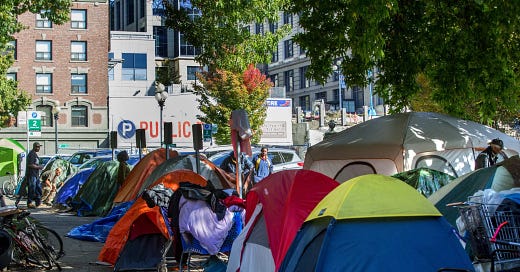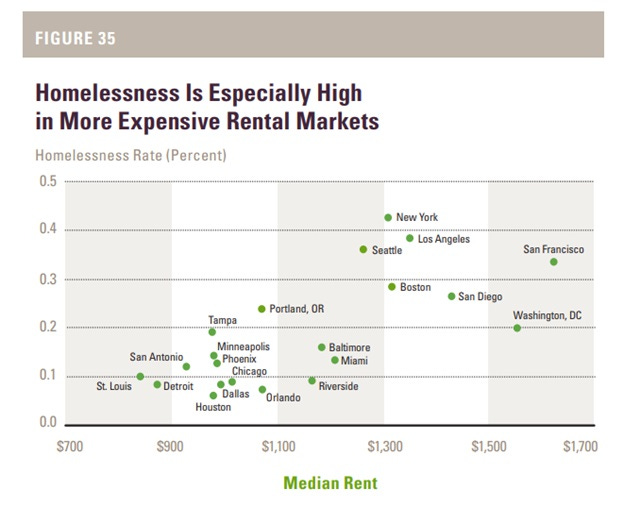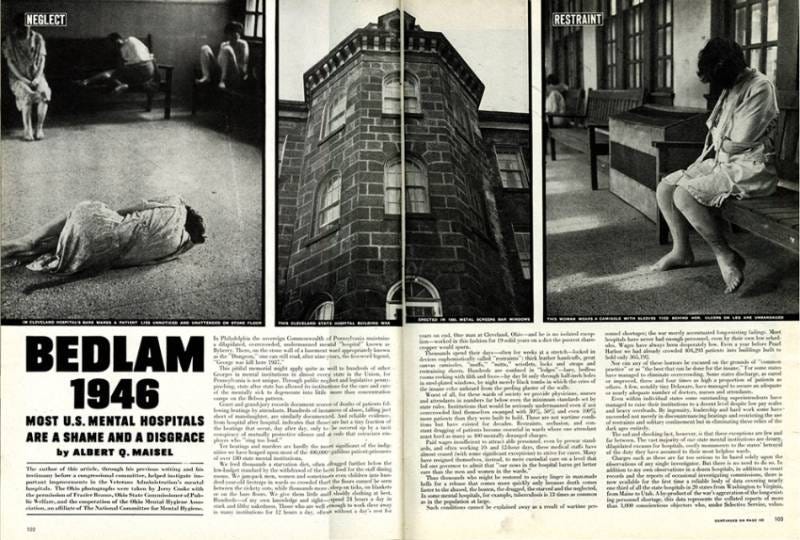Compassion for the homeless demands coercion
We have a duty to get people off the street whether they want to or not
American cities are now well into their second decade of an acute homelessness crisis. If you live in a major American city, especially on the West Coast, you’ve seen it first-hand. You’ve edged warily past tents crowding sidewalks. You’ve dodged people passed out in sleeping bags or in bus shelters, lying down or sitting or standing up. You’ve been shouted at by a lunatic, or been on a bus or subway compartment that gets studiously silent pretending not to notice aggressive unhinged behavior, praying it won’t spill over into actual violence. You probably avoid going to certain parts of town, especially if you are a woman or have a family. And even if you don’t, you have noticed the broken plate glass windows and increased security measures in stores that invariably accompany the presence of large numbers of the homeless. The crisis has affected every urban American, stalled urban renewal, and fueled suburban retreat.
But the crisis is not equally distributed, with some cities doing much worse than others. The chart below contains both absolute numbers and per-capita rates. On a per-capita basis, Los Angeles has a homelessness rate 9 times that of Houston.
And note that while NYC has a sky-high homelessness rate, it manages to stick 95% of them in shelters, as does Boston and DC. Meanwhile, 75% of LA’s 55,000-strong army of homeless bivouac down right on the sidewalk, along with two-thirds of the Bay area and half of the Seattle metro. On the West Coast, we prefer our homeless al fresco.
Why? Why does the West Coast in particular do such a poor job of getting the homeless into temporary shelters? Why do West Coast homeless camp on the streets? Very simply — it’s because we have decided to allow them to do so.
The progressive orthodoxy on this topic insists that homelessness is a simple function of housing prices. Noah Smith published this long piece a couple years ago arguing this at length. His guest author, Aaron Carr, goes down the list of other common rationales for the mass presence of people living on the street, especially mental health and drugs, and demonstrates the correlation of homelessness with these other explanations is quite weak. On the other hand, housing costs seem to bear a strong relationship to the rate of homelessness.
The causal explanation of why high housing costs leads to homelessness goes something like this: a certain percentage of the population is economically precarious, barely able to afford rent, and then a sudden job loss or rent increase, or any other crisis, leads to an eviction which forces them onto the street. It’s a believable and sympathetic narrative, but one must square it with other analyses which find a very modest relationship between changes in the cost of living and changes in homelessness. In the chart below, if you exclude the small handful of cities that saw rent increase by more than 60%, you would be pretty hard-pressed to draw any regression line at all. It just looks like noise.
Personally I approach these statistics with a three-finger pinch of salt, because I suspect what they’re measuring does not capture the problem people complain about when we complain about “the homeless.” It is not the mere fact of homelessness that causes the deplorable street conditions in American cities. Rather, it is the behavior of a small minority of homeless in spoiling the public commons with crime, pollution, open drug use, and aggression. The vast majority of people experiencing homelessness do so on a very temporary basis, with over 75% finding new permanent housing in the first six months.
When activists like Aaron Carr provide figures blaming “the problem of homelessness” on the cost of housing, they’re performing a neat sleight of hand, conflating the experience of temporarily having nowhere to live (literally, homelessness) with chronic street dysfunction among a small permanent underclass (“the homeless”). People involved in the former far, far outnumber the latter but nobody complains about them because they don’t make trouble for anyone. The problem of “homelessness” (temporarily not having anywhere to live) is solved inside of six months for 75% of the people who experience it, while “the homeless” (the permanent street-dwelling underclass) remains an intractable issue immune to billions in spending on a growing cottage industry of faux solution peddlers and paper pushers.
And in any case, none of these graphs or any other quantitative analysis can answer the simple policy question: why does New York not permit its homeless to camp on the streets, but Los Angeles does?
One point on which I agree with Carr and others: it’s not progressivism per se. Yes, progressive judges and prosecutors decline to prosecute the dozens of petty crimes that would remove many of the permanent underclass from the street at least temporarily. But the motivating ideology which permits the voters of San Francisco and Los Angeles to allow street camping in such vast numbers isn’t progressivism, but rather a nihilistic, judgement-free libertinism that refuses to assert that the decision to shit on the sidewalk and smoke crushed fentanyl pills at school bus stops is any less valid a lifestyle choice than living in a townhouse and writing B2B software. It’s the animating spirit of West Coast culture since the days of first settlement, and its flag is well known.
This is a distinctly American philosophy, and it finds its truest expression among the brave pioneers who made the perilous journey across the great plains to settle the coast originally, and among their modern equivalents leaving home from the rest of the country and indeed the world for the promise of riches and glory, yes, but more than that — for the promise that they can invent themselves in their new home and live a fully authentic life of their own creation, according to their own rules, where no one has the authority to tell them no. This is a beautiful sentiment in the hands of the wise and capable: it built Silicon Valley, the movie industry, the grunge music scene, the craft beer industry, and a hundred wild and wonderful art movements. And it has been an absolute disaster for the least capable among us, who now dwell in tents on sidewalks committing slow suicide while they degrade the quality of life of everyone around them, because no one is willing to tell them no. No, you can’t obstruct the sidewalk with your tent. No, you can’t shout threats on this bus full of commuters. No, you can’t smoke crushed pills across the street from this elementary school. Cities full of progressive fervor, who tax themselves endlessly for any worthy cause, who voted against Trump 80/20, will do anything to help their street underclass except to say no. An army of volunteer do-gooders will make generous offers of shelter to the same few thousand street dwellers who turn them down over and over, but they will never put their foot down to say no: you must not live like this, it is hurting you and us both, you must desist or we will make you desist. This unwillingness to apply any degree of coercion in service of a solution is the fundamental element of West Coast culture, and it’s killing the very people it’s meant to help.
One often hears someone on the left lament that Reagan closed the asylums as a callous cost-saving measure, pinning the blame for street lunatics on a heartless right wing. But this popular myth is pure revisionism. The deinstitutionalization movement was progressive through and through, contesting the right of the state to detain the insane against their will when they had committed no crime. It was already in full swing before Reagan was governor or president — he merely presided over it, as well as repealed a bill passed by Carter providing for non-asylum “community mental health centers” that had no power to detain anyone against their will. And the conditions inside the asylums were often truly deplorable, it must be acknowledged. But the idea that many normal healthy people were involuntarily committed was always a farce, and it’s far from obvious that the lives of misery and deprivation led by the insane on the street are better than confinement to a ward, to say nothing of the costs they impose upon the rest of us. We won’t commit crazies against their will for the same reason we won’t make them pack up their tent and go to a shelter.
The permanent street underclass will not snap out of it and accept shelter and treatment of their own volition. They must be forced: forced to get clean of drugs, forced into psychiatric evaluation and treatment, forced to sleep in a shelter instead of in a tent. They won’t do it on their own, and we won’t make them, so there they sit or lie, day after day, and no amount of money will change that. Talk to anyone with a relative or close friend living on the street, someone who suffers from schizophrenia or crippling addiction, and they will tell you they have begged the relevant authorities to intervene, to force their loved ones to get the help they need to resume a life worth living. If they’re lucky, their unfortunate son or brother does something serious enough to actually wind up in prison, which is the only circumstance that can temporarily interrupt their self-destructive behavior. But that’s uncommon, and typically too brief to cause lasting change even when it occurs. The very lucky ones who get clean in jail or forcibly treated in a psych ward get a soft landing with almost unbelievably devoted loved ones who help them turn their life around. But more often, they’re back on the street immediately, resuming their slow-motion suicide. The outreach agencies will offer help a hundred times but never once make anyone take it.
This is monstrous cruelty masquerading as compassion. It’s moral cowardice on a monumental scale. Like it or not, the permanent street underclass are de facto wards of the state — they live on our tax dollars, on public property, shuttling in and out of a never-ending series of state agencies and emergency services. They are our responsibility to help, whether they want it or not. We have chosen to abdicate that responsibility, to our great shame.










There’s also the fact that if NYC doesn’t get them off the streets, winter will.
Drug encampments follow the weather, along with the handouts.
There's a phrase I keep thinking when I see topics like this: "Chaos is a policy choice."
Allowing crazy people to take over streets and parks and libraries? It's a policy choice.
Allowing whole neighborhoods to become cesspools of crime where nobody is safe walking down the street at night? Policy choice.
Allowing a public school classroom to be unmanageable because of kids who can't or won't behave? Policy choice.
There are countries that make different policy choices, and we could, as well. Probably we won't because these policy choices come down to tradeoffs between different values and different interest groups, but there's no law of nature that says that public spaces must be owned by crazy people sleeping rough, or aggressive panhandlers, or small-time criminals. We could just decide not to let that go on.